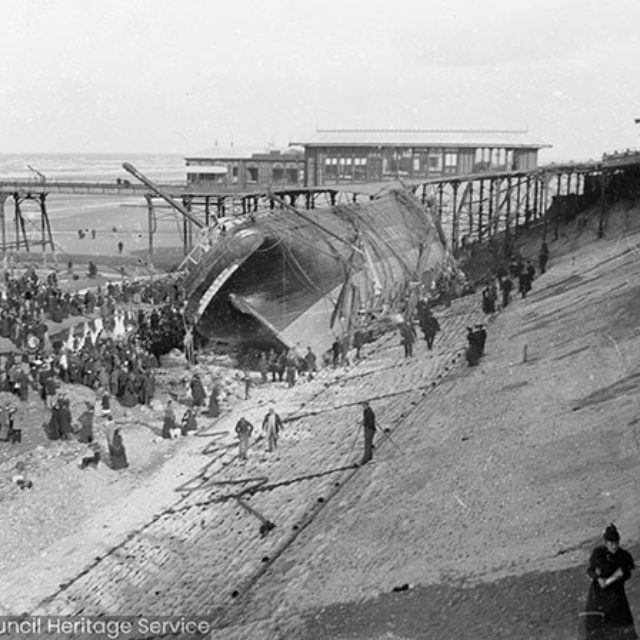By Mike Coyle

What was the Foudroyant?
In fact there were two ‘Foudroyants’. The one with the Blackpool and memorabilia connections is ‘HMS Foudroyant’.
Launched in Plymouth in 1798; she was an 80 Gun, ‘Full Rigged’ warship, named after the French ship, bearing the same name, captured in 1758. The name is derived from the French for ‘Thunderbolt’.
HMS Foudroyant had a somewhat chequered service, despite service during the French Revolutionary and Napoleonic Wars, including a three year spell stationed on the River Plate, in Rio de Janeiro; action in Egypt; Royal visits; Troop Transport; roles as ‘Flagship’; punctuated by long periods in dock for repairs, or service as a tender or guard ship. She was decommissioned in 1812. In her later years she was a gunnery training ship and a naval training ship. Its most celebrated role was as Nelson’s ‘Flagship’ from June 1799 until 1800.
In June 1891 she was put on to the Navy’s ‘Sales List’. She was bought by J Read of Portsmouth for £2350 and quickly resold to German shipbreakers, who promptly started dismantling the upper decks, prompting protests in the press and at the highest levels in the UK. Arthur Conan Doyle resorted to poetry and ‘Punch’ magazine published a follow-up piece ridiculing the Royal Navy decision to sell the ship off.
She was re-bought at a cost of £6,000 and brought to London eventually by Mr Geoffrey Wheatly Cobb, with a plan to redevelop the Foudroyant as a boys’ training ship, at a cost of £20,000. In order to recoup costs of refurbishment to original design, the ship was to be exhibited at seaside resorts.
By 1896 the Foudroyant, ‘Nelson’s Flagship’ was on tour, carrying a crew of 27, including boy sailors. On 11 June 1897, she lay off Blackpool Promenade, between North and Central Piers, about a mile out; setting the scene, for what was to be a short seasonal attraction for the visitors and an opportunity for Mr Cobb to make a contribution to the running costs of the venture.
Entry to the ship was a shilling and the boy sailors provided a band playing nautical ditties. On the 15 June a new venture was tried – dancing on the upper Deck, by all accounts a great success.
On the evening of the 15 June, the weather was fine, albeit with a sprinkling of fine rain, but nothing to keep the crowds away.

By 4am on the 16 June a rapidly developing storm had blown up, almost ‘out of the blue’. By 6am a ‘an iron chain as thick as a man’s wrist’ had snapped by the force of the wind and sea, pushing the Foudroyant on to the beach. The force of repeatedly ‘bumping’ on the beach, with the ebb and flow of the tide, causing her hull to breach in places, snapping masts and tearing sails,. Now on her side and flooded, she rolled and writhed in the storm tide.
The owner and crew were still on board and the ‘Samuel Fletcher II’ was brought from the Lifeboat House on Lytham Road, harnessed up and towed up the Promenade now crowded with sightseers. She launched into a wild surf at 1pm, a full hour after being called. Battling through debris, rigging and broken timbers, the ‘Samuel Fletcher’ struggled to stay on station, but managed to scoop all to safety. The full complement of twenty seven and Mr Wheatley Cobb were rescued and brought to shore under the gaze of excited crowds on the Promenade.
The following day, the damage was clear. It was possible to climb into the mud-caked and battered hulk via a hole created by one of the 32 pounder guns, which had broken loose on the lower deck. The upper deck was strewn with timber, planking and guns wrenched from their carriages. Nevertheless, the crew attempted to gather their belongings left their in the hurry of escape. The incoming tide of the 18 June washed over her.
By the 19 June, prompted by the enterprising efforts of Blackpool’s Marketing Manager, visitors from all over the north were filling trains to see the spectacle and the resort. It hadn’t been a good season- until the wreck. The Queen’s Jubilee year had kept folk at home.
Losses for Cobb were estimated at £30,000 and there was no insurance cover. Already there was talk of the value of the remaining hulk and options available: perhaps sold piecemeal- guns, timber, etc. or made watertight and retained as tourist attraction. The directors of North Pier had a more pragmatic approach: they sought an injunction to have the wreck removed. If it broke away or broke up further it would pose a hefty threat to the pier structure. By mid July, Foudroyant’s fate was sealed. Cobb had agreed with a Clydebased salvage company to re-float the wreck and tow it away for dismantling. Progress was being made, however, the Foudroyant was not yet finished.
A steam tug, the ‘Anna’, employed by the salvage company found itself in difficulties during another freak storm and had pulled away from the Foudroyant to anchor offshore to ride out the squall. She was carrying ropes and some of the guns from Foudroyant. With the weight of the wind and tide, she slipped her anchor and drifted to shore. Deluged, she was unable to operate pumps and steam engines and eventually only the mast was visible in the swell. The crew had been taken off by off duty fishermen using a pleasure boat.
The following morning debris and wreckage were strewn along the North beach.
In front of the ever present crowds on the North Promenade, another salvage attempt was made in mid August. The ‘Aurora’, a trim, neat 300 tonner arrived to restart operations, loading more guns, ropes, rigging, timbers and artefacts from HMS Foudroyant. The ‘Aurora’ was tethered to her broadside and as the tide increased, her moorings gave way and she broke free, bobbing precariously in the swell rolling heavily with every wave until she hit one of the beach banks. She was rapidly filling with water. As the tide rolled in she was battered against the sea wall - another thrilling spectacle for the Blackpool crowds.
On the 20 August, the Gazette reported, ‘Never has there been a season in which exciting incidents have been so plentiful’.



